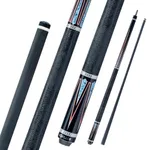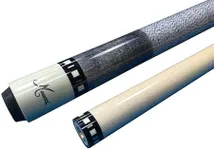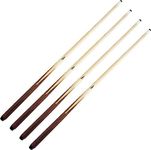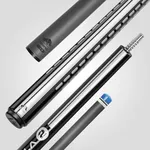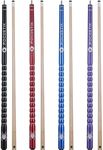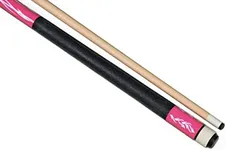Buying Guide for the Best Cue Pool Sticks
Choosing the right cue pool stick can significantly enhance your game and make playing more enjoyable. The right cue stick should feel comfortable in your hands, suit your playing style, and be of good quality to ensure durability and performance. Here are some key specifications to consider when selecting a cue pool stick and how to navigate them to find the best fit for you.WeightThe weight of a cue stick is crucial as it affects your control and the power of your shots. Cue sticks typically range from 17 to 21 ounces. Lighter cues (17-18 ounces) are easier to control and are often preferred by players who focus on finesse and precision. Heavier cues (20-21 ounces) provide more power and are suitable for breaking shots or players who prefer a more forceful game. If you are a beginner, a mid-range weight (19 ounces) is a good starting point to balance control and power.
LengthCue sticks generally come in standard lengths of 57-58 inches, which are suitable for most adult players. However, shorter cues (48-52 inches) are available for children or players with shorter arm spans. Longer cues (59-61 inches) can be beneficial for taller players or those who prefer a longer reach. Choose a length that feels comfortable and allows you to maintain proper form and control during your shots.
Tip DiameterThe tip diameter of a cue stick affects the precision and spin you can apply to the cue ball. Tips typically range from 11 to 14 millimeters. Smaller tips (11-12 mm) offer greater control and are ideal for advanced players who use a lot of spin. Larger tips (13-14 mm) provide a larger surface area for striking the ball, making them more forgiving and suitable for beginners. Consider your skill level and playing style when choosing the tip diameter.
MaterialCue sticks are made from various materials, including wood, fiberglass, and graphite. Wooden cues are the most traditional and offer a natural feel and good balance. Fiberglass and graphite cues are more durable and resistant to warping, making them a good choice for players who need a low-maintenance option. Your choice of material should depend on your preference for feel, durability, and maintenance.
WrapThe wrap of a cue stick provides grip and comfort. Common wrap materials include leather, linen, and rubber. Leather wraps offer a smooth, luxurious feel and good grip. Linen wraps are durable and provide a textured grip that absorbs moisture, making them ideal for players with sweaty hands. Rubber wraps offer a soft, cushioned grip and are easy to clean. Choose a wrap that feels comfortable in your hands and provides the grip you need for consistent shots.
JointThe joint is where the two pieces of a cue stick connect. Common joint types include wood-to-wood, stainless steel, and quick-release joints. Wood-to-wood joints provide a solid, traditional feel and are preferred by many professional players. Stainless steel joints offer durability and a consistent hit. Quick-release joints allow for easy assembly and disassembly, making them convenient for players who travel with their cue. Consider the type of joint that best suits your needs for feel, durability, and convenience.


